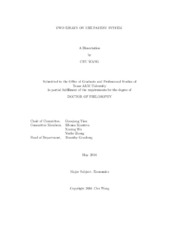| dc.description.abstract | The effectiveness of patent system design has been studied for decades from both microeconomic and macroeconomic perspectives. The existing literature demonstrates that innovations provide product diversity, supporting the view that specialization leads to increasing returns. Moreover, innovators are often rewarded patent rights to recover the cost of innovation. The monopolistic power provided by patents, on the other hand, can result in deadweight loss, hurting social welfare. Traditional studies on designing effective paten systems have investigated the effect of human capital on growth-assuming infinite patents. This thesis, however, investigates two issues: how various factors influence the optimization of patent policy, under which the mechanism designer controls the expected length of patent to guarantee maximization of social welfare; and how the incumbent patentee reacts to the new entrant in the market according to existing patent policies.
In this thesis, we first analyze the environment in which innovators can engage in research that produces technological improvements. Each invention represents a new type of intermediate input. The social planner faces a tradeoff between the needs of encouraging the innovators, and the fact that the monopolistically competitive equilibrium provides less intermediate inputs. In this study, we find that the optimal patent policy is a two-stage arrangement. To counteract the slower technological growth resulting from monopolistic power, the social planner first grants no monopolistic power to the innovators. Then, after the critical time point when the resource in the economy becomes rich, the social planner grants the innovators infinite protection.
From the view of market participants, we evaluate a patent-holding incumbent’s incentives to litigate, settle with, and accommodate a new market entrant. Patent protection is uncertain and is characterized by patentability standards and patent breadth determined during litigation. While litigation has the benefit of blocking an infringing product, it carries a risk of patent invalidation. As a result, the incumbent accommodates large improvements. Improving the incumbent’s market position strengthens his litigation incentives, but it can also benefit the entrant since a stronger incumbent mitigates market competition from non-patented product. | en |


